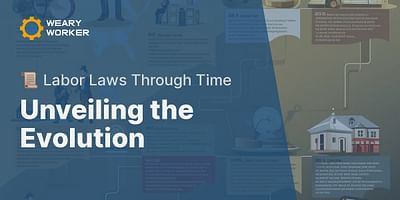Ava Smith is a labor historian with a deep love for storytelling. She enjoys exploring the past to understand the present and future of labor laws. Ava is a Pennsylvania native and enjoys hiking in her free time.
Right-to-work laws are a contentious issue in the United States due to their far-reaching implications for workers, unions, and employers alike. Understanding these laws necessitates a deep dive into their historical context, current applications, and potential future impact.
Let's Dive into the Intricacies of Right-to-Work Laws 📚
At their most basic, right-to-work laws prohibit agreements between trade unions and employers that mandate workers' membership, payment of union dues, or fees as a condition of employment. Essentially, these laws give workers the 'right to work' without necessarily joining a union. This concept, while seemingly straightforward, is a major point of contention in labor issues across the US.
Balancing the Scales: The Good, the Bad, and the Ugly of Right-to-Work Laws ⚖️
Proponents of right-to-work laws argue that they protect a worker's freedom of association and prevent forced union membership. They contend that workers should have the right to decide whether to join and/or financially support a union. Some also argue that these laws can attract businesses and stimulate economic growth.
On the other hand, opponents of right-to-work laws believe they undermine unions' bargaining power, leading to lower wages and benefits for workers. Critics argue that these laws allow "free riders" - workers who benefit from union representation without contributing to the costs of such representation. This, in turn, weakens unions financially and dilutes their ability to effectively negotiate on behalf of workers.
Average Wage Difference Between Right-to-Work and Non-Right-to-Work States
It's worth noting that the debate isn't purely theoretical. The impact of these laws can be seen in real-world labor market outcomes. For example, studies suggest that wages in right-to-work states are generally lower than those in non-right-to-work states, though other factors may also contribute to these wage differences.
A Trip Down Memory Lane: The Tumultuous History of Right-to-Work Laws 🕰️
Right-to-work laws have a contentious history rooted in the labor struggles of the 20th century. The passage of the Taft-Hartley Act in 1947, which allowed states to adopt right-to-work laws, was a significant turning point in American labor law history.
Let's take a closer look at the historical events that have shaped the trajectory of right-to-work laws in the US:
As we can see, the journey of right-to-work laws in the US has been marked by significant milestones, each contributing to the current state of labor rights and economic policy.
Over the decades, these laws have been a focal point of disputes over labor rights and economic policy. Their adoption varies widely among states, reflecting differing political and economic landscapes.
As mentioned earlier, the adoption of right-to-work laws varies widely among states. Let's take a visual look at this variation.
As you can see, the distribution of right-to-work states is spread across the country, reflecting the diverse political and economic landscapes of the United States. Now, let's delve into what the future might hold for these laws.
Gazing into the Crystal Ball: What Lies Ahead for Right-to-Work Laws? 🔮
The future of right-to-work laws is uncertain and will likely continue to be a contentious labor issue in the US. The political climate, court rulings, and shifts in public opinion all play a role in shaping this future. As such, it's crucial for workers, employers, and policymakers to understand the implications of these laws.
Understanding Right-to-Work Laws
Test your knowledge about the history and impact of right-to-work laws in the United States.
Learn more about Understanding Right-to-Work Laws: History and Impact ✏️ or discover other Weary Worker quizzes.















